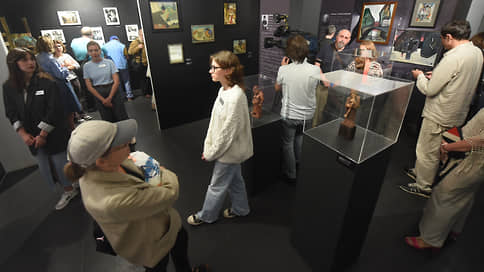Exhibition dedicated to “Dovlatov’s Day” in St. Petersburg. Review
[ad_1]

In one of the most stable and interesting galleries in St. Petersburg – KGallery on the Fontanka Embankment – an exhibition “Artists of the Dovlatov Circle” has opened. The exposition is timed and is part of the “D-Day” – “a festival with a pronounced human face, dedicated to Sergei Dovlatov and his time.” The festival is being held for the seventh time, this year’s slogan, as always, is taken from a completely dimensionless list of Dovlatov’s mots: “Irony is the favorite, and most importantly, the only weapon of the defenseless.” Dovlatova studied the visual background of extremely literary-centric creativity Kira Dolinina.
No matter how right the ideological inspirer of all D-Days, the historian Lev Lurie, who refers visitors to the exhibition at KGallery to the fact that “Sergei Dovlatov had artistic abilities, painted all his life, studied for some time at the School of Art, thought about becoming a sculptor or jeweler”, the literature of this writer is, first of all, razor-sharp words. Not without reason, it was his prose that became a quotation book, by which the generation recognized “their own”, who enthusiastically read the Leningrader who had already left the USSR in post-perestroika publications. For the next generation, who already got the five-volume Dovlatov, the quotation fund became even larger.
The posthumous fame of the writer who never saw his books published in Russia turned out to be deafening, but to say that this was the glory of the head of the “circle”, a certain center of the artistic world of the underground culture of Leningrad in the 1960s and 70s, would be an exaggeration. Dovlatov has always been a prominent figure (even if we do not take into account the giant growth of our hero, noticeable among the predominantly short children of wartime) of the Leningrad underground, but the centrifugal forces of these circles still led to other figures. “Akhmatov’s orphans” plus Kushner and Losev were the undisputed leaders in poetry, speaking the same language with the Silver Age. On the other hand, there were also much more avant-garde Leonid Aronzon, Viktor Krivulin, Arkady Dragomoshchenko. In prose, Valery Popov, who was quite published and stylistically close to many disgraced “metropolitans”, coexisted peacefully, and Boris Vakhtin, Igor Efimov, Vladimir Maramzin, who stepped on the neck of the officialdom of the Writers’ Union. In their group “Citizens” in the late 60s, Dovlatov was invited, who had previously appeared in literary circles as a loner.
You can search for “artists of the Dovlatov circle” in different ways. You can go from the premise given by Lurie in the explication to the exhibition, that is, chronologically: “Anna Akhmatova called the “Bronze Age” the end of the 1960s – the time of Joseph Brodsky, Sergei Dovlatov, Sergei Yursky, Oleg Tselkov, Mikhail Baryshnikov, Boris Tishchenko, Ilya Averbakh . Talents always go in flocks: in Leningrad, aesthetic free-thinking almost inevitably led to personal acquaintance, regardless of profession. Maybe biographically. Both circles will intersect in one way or another: Leningrad is a small city, and artistic circles are close. Everyone is familiar with everyone, but ideologically, stylistically, and friendly are not necessarily close at all.
The exhibition at KGallery presents two layers of exhibits: photographs and paintings/graphics. Nine photographs by Gennady Prikhodko, who is part of those same underground circles: pictures around the famous exhibition in the Nevsky Palace of Culture in 1974, which greatly quarreled underground Leningrad artists; workshops of the poet Konstantin Kuzminsky with guests and the artist Anatoly Basin with a nude model; several times – abstractionist Evgeny Mikhnov-Voitenko; photo from the social history of art of Soviet nonconformists – the future New York gallery owner Eduard Nakhamkin, who will exhibit dozens of future émigré artists from the USSR. These documents form the idea of a “circle” that has practically no boundaries: Dovlatov is not on them next to Alexander Arefiev, but there is no doubt that they knew each other either. Everyone went to exhibitions of unofficial artists in the Palace of Culture. Gaza and the recreation center “Nevsky”, and even those who loudly refused to participate in them (as the “Arefyevites” who fundamentally refuse publicity), knew even better.
Graphic sheets and a few paintings at the exhibition do not form a “circle” either. The centers of attraction for the exhibiting artists (Mikhnov-Voitenko, Mikhail Kulakov, Oleg Tselkov, Eduard Bersudsky, Gaga Kovenchuk, Mikhail Shemyakin, Yakov Venkovetsky) were completely different heroes of the Leningrad underground. But personal acquaintances with Dovlatov, common gatherings in workshops, common quotations and jokes, sometimes joint work in rare editorial offices that accepted this “anti-Soviet” art (primarily in the Koster magazine, whose chief artist was the future author of the Soviet Hobbit, Mikhail Belomlinsky ), the general circle of the first beauties of the city, finally, can create a feeling of a certain community, if not art, then space. Strategies for the survival of artists in the closeness of the Brezhnev decades were different, but most often salvation was seen in private communication. In this sense, the D-Day exhibition is very honest: it is chamber-like, optional in composition, does not claim to be inclusive, and sets the current tone. Group photos tell about those who stayed and those who left. Many will die young. The rest will do everything not to forget the departed and, in general, that time. Do not perish in history. Don’t lose your memory. Leonid Aronzon, who died in 1970, wrote about this “circle”: “You can count us all on the fingers, // but on the fingers! Friends, where did // I get such an honor // to be among you? But how long will I be? Dovlatov will leave at 48, Brodsky at 55. And the circles they launched on the water still diverge. “D-Day” is about memory, irony, Leningrad identity and, of course, vodka and wine glasses. A great occasion to drink for them and for us.
[ad_2]
Source link






